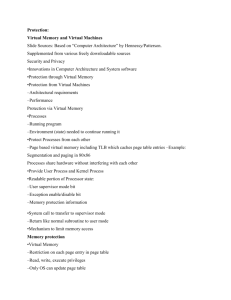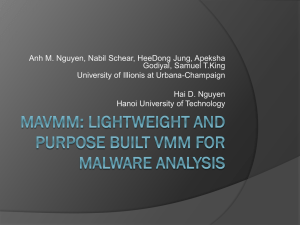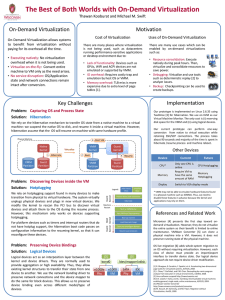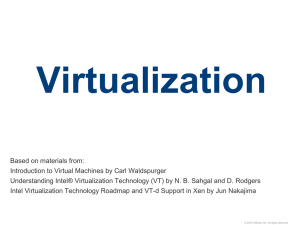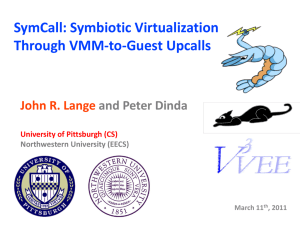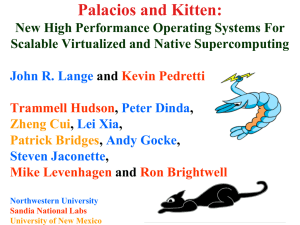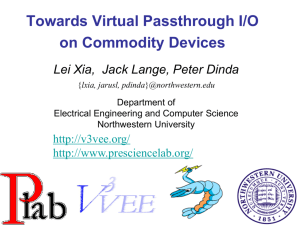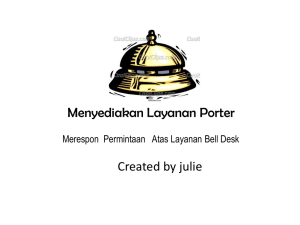Document 5271810
advertisement
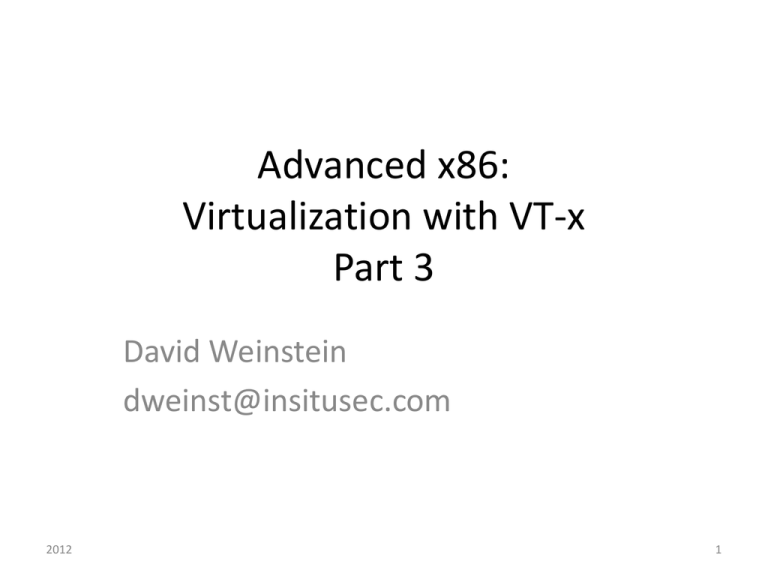
Advanced x86: Virtualization with VT-x Part 3 David Weinstein dweinst@insitusec.com 2012 1 All materials are licensed under a Creative Commons “Share Alike” license. • http://creativecommons.org/licenses/by-sa/3.0/ 2 Real mode guest VM • What if we wanted to run some real mode code as a guest VM. – Maybe because support for Virtual-8086 emulation is unsupported by the CPU’s compatibility mode in 64-bit mode • Allan Cruse (Prof. Emeritus @ University of San Francisco) shows us how to do this with a guest VM – http://www.cs.usfca.edu/~cruse/cs686s07/lesson24.ppt • So I fixed the code to work with recent Linux 3.* kernels • We’ll get to experience the fun of calling a BIOS interrupt in a guest VM container – In the comfort of our Linux environment 2012 4 The Real Mode Address Space • Code that uses real-mod addresses is limited to the bottom megabyte of memory: 0xFFFFF one-megabyte address-space 0x00000 ROM Read-Only Memory (BIOS) ROM VRAM Read-Only Memory (Video) Video display memory EBDA Extended BIOS Data Area RBDA IVT ROM-BIOS Data Area Interrupt-Vector Table Ref: http://www.cs.usfca.edu/~cruse/cs686s07/lesson24.ppt 2012 Real mode guests… for reals • To support guest real-mode execution, the VMM may establish a simple flat page table for guest linear to host physical address mapping. 2012 6 BIOS Services • • • • • • • 2012 int 0x10: video display services int 0x11: equipment-list service int 0x12: memory-size service int 0x13: disk input/output services int 0x14: serial communications services int 0x15: system software services More on BIOS stuff http://wiki.osdev.org/BIOS 7 Int 0x11: Equipment List result 15 14 13 12 11 10 9 8 7 6 5 4 3 2 1 0 ax Internal modem (1=yes, 0=no) Number of printer-ports Number of serial-ports Number of diskette drives (if bit 0 is set) (00=1 drive, 01=2 drives, etc) Initial video-display mode (11=80x25 monochrome, 10=80x25 color, 01=40x25 color, 00=EGA/VGA/SVGA) PS/2-type pointing-device is installed (1=yes, 0=no) External math-coprocessor installed (1=yes, 0=no) 2012 Diskette available for booting (1=yes, 0=no) 8 linuxvmm.c • Character-mode Linux device-driver – Loaded as a kernel module at runtime • Accessed via a /dev/vmm • Can use standard functions like fopen, mmap, and ioctl to interact with the device • Compile with included mmake.cpp – g++ -o mmake mmake.cpp • Read the README file in the linuxvmm directory 2012 9 tryoutpc.cpp • Uses an ioctl on the /dev/vmm – Ask the host VMM to continue to execute the kernel’s code in 64-bit mode, and to launch a Guest VM that will execute the real-mode procedure in Virtual-8086 mode – We’ll supply the register values to be placed in the guest VM as part of the ioctl. – And we’ll see the result when the guest exits and returns the resulting register values. 2012 10 dram.c • Another kernel module to allow us to browse the physical memory of the system – Exposed via /dev/dram – Best viewed with fileview (in linuxvmm dir) • g++ -o fileview fileview.cpp • sudo ./fileview /dev/dram 2012 11 Lab: ‘real-mode’ guest VM container • Purpose – Demonstrate execution of a real-mode guest – Execute BIOS interrupt 0x11 to obtain the available system device hardware • Steps – README in directory 2012 12 VM “Introspection” (1) • By registering with the VMCS events that cause VMExits, the transition from VMX non-root to root mode allows the inspection of guest state and memory, thus allowing the external inspection of the guest. • We’ve discussed a number of events that can trigger a VM exit and allow for inspection of the guest system’s state • We’ve also shown how we can essentially create callbacks that get hit when the VM exit conditions match an event of interest 2012 18 VM “Introspection” (2) • Since the CR3 register contains the page directory pointer during a context switch (and thus VM Exit), this can be used to identify the upcoming process before it executes. • At the end of the day, this is a tool that can be used for malware analysis, system integrity checking, code isolation, etc. 2012 19 General Hardware VM Based Rootkit • Virtual Machine Based Rootkit (VMBR) • Start with CPL=0 • Allocate some unpaged physical memory – Ensure no linear mappings to VMM after guest entry • Move running OS into VMCS • Intercept access to hardware (IO ports, …) • Communicate to hardware VM rootkit via sentinel instructions 2012 21 Keylogging in VMBR • Setup VMCS appropriately – Determine the keyboard’s IO ports – Intercept IO port access and handle/reinject the event to the guest VM. • Look up the lab Xeno made for talking to the keyboard controller – http://opensecuritytraining.info/IntermediateX86.htm l • Another example, see Hyperdbg – https://code.google.com/p/hyperdbg/source/browse/ trunk/hyperdbg/keyboard.c 2012 22 bpknock 2012 23 bpknock 2012 24 bpknock 2012 25 Blue Pill Idea (Simplified) 2012 26 Vitriol BH USA 2007. Goldsmith and Lawson 2012 27 Virtualization projects • Lguest, Xen, QEMU/KVM • Vitriol (Matasano), BluePill/NewBluePill (ITL) • Debugging – Hyperdbg, virtdbg • Academic – SubVirt (Microsoft Research), V3vee Palacios (NWU), SecVisor (CMU), BitVisor (University of Tsukuba) 2012 28 NewBluePill • Created for a Black Hat training session • Copyright terms are limiting (reproduced below) • https://bluepillstudy.googlecode.com/svn/tru nk/nbp-0.32-public/ ; Copyright holder: Invisible Things Lab ; ; This software is protected by domestic and International ; copyright laws. Any use (including publishing and ; distribution) of this software requires a valid license ; from the copyright holder. ; ; This software is provided for the educational use only ; during the Black Hat training. This software should not ; be used on production systems. 2012 29 Lguest • Simple x86 hypervisor for hosting other Linux kernels • Load kernel module which you will load into running kernel • Simple I/O for communication 2012 30 Detecting Virtualization/VMBRs • Godsmith, Lawson proposed detection heuristics [1] – Functional (behavior or state changes) – Side-channel (timing variations) • Point methods – Processor errata – VMCall functions/CPUID results – Look for artifacts in processes, file system, and/or registry, memory. – Look for specific virtual hardware – Look for specific processor instructions and capabilities • See RedPill, NoPill, and ScoopyNG – ScoopyNG = Scoopy Doo + Jerry [1] http://www.matasano.com/research/bh-usa-07-ptacek_goldsmith_and_lawson.pdf 2012 31 Instructions That Cause VM Exits Unconditionally • CPUID, GETSEC, INVD, and XSETBV. This is also true of instructions • introduced with VMX, which include: INVEPT, INVVPID, VMCALL,5 VMCLEAR, VMLAUNCH, VMPTRLD, VMPTRST, VMREAD, VMRESUME, VMWRITE, VMXOFF, and VMXON. • Meaning there should be a timing difference caused by a VM exit 2012 32 Instructions That Cause VM Exits Conditionally • If you can figure out whether the software trying to escape detection will be forced to exit to support a particular pre-existing feature • Section 25.1.3 2012 33 RedPill • Joanna Rutkowska, 2004 - “Red Pill... or how to detect VMM using (almost) one CPU instruction” – http://www.invisiblethings.org/papers/redpill.html • Using SIDT (Store Interrupt Descriptor Table Register) instruction to profile the current value in the IDTR • She had found that the most significant byte of the IDTR had a predictable value in VMWare 4 and VirtualPC, which was different from what it was in an non-virtualized system Ref: http://opensecuritytraining.info/IntermediateX86.html 2012 34 Measuring time (1) • CPU Tick Counter – RDTSC instruction – resolution: number of processor cycles (super high!) – very accurate, but trivial to cheat! • TSC offsetting/RDTSC VMExit • High Precision Event Timer (HPET) and other local timers – Might have a high resolution – But we can cheat them – e.g. interrupt interception http://invisiblethingslab.com/resources/bh07/IsGameOver.pdf (Slide 54) 2012 36 Measuring time (2) • Real Time Clock (RTC) – I/O with RTC device – resolution: milliseconds (poor) – relatively easy to cheat (I/O interceptions) • External clock – e.g. NTP protocol – resolution: 10 milliseconds (very poor) – can not be cheated using generic approach – only attacks against specific implementation http://invisiblethingslab.com/resources/bh07/IsGameOver.pdf (Slide 54) 2012 37 TLB Profiling • Based on the belief that a VMM puts the hardware TLB entries to 0 if it is intercepting an instruction. • Technique – Detector can watch timing access of a page, calling a possibly intercepted instruction, and then once again timing access to the same page – Comparing both results should indicate a longer access time (from an external reference) if there has been an interception. 2012 38 Volatile Memory Capture over DMA • Access all of physical memory over external peripheral interface (e.g. Firewire) • It should then be possible to detect a VMBR by searching for its signature. – What signatures would you look for having learned what we know about the various data structures? 2012 39 BlueChicken/TOCTOU • “It's a funny feature that allows Blue Pill to defeat timing-based virtualization detectors, so they can't find out that they're inside a VM. Obviously we do not need Blue Chicken in case there is Virtual PC in the system or any other application that makes use of hardware virtualization already.” - Joanna Rutkowska • Blue Chicken puts Blue Pill into a mode where it doesn’t interfere or cause VM exits. This sleep mode means it doesn’t hook anything and could remain in memory encrypted to avoid detection. • This is an example of a Time of Check Time of Use attack designed to protect Blue Pill from detection. 2012 40 Nested Virtualization • Ben-Yehuda et al. The Turtles Project: Design and Implementation of Nested Virtualization – Talk: http://www.youtube.com/watch?v=FbH63kVGTek – “… our approach multiplexes multiple levels of virtualization … on the single level of architectural support available” • Alexander Tereshkin (ITL), Bluepilling the Xen Hypervisor • Other uses – IaaS providers – Live Migration – Debugging hypervisors • “Nested virtualization is needed in case we have some other applications in the target system that also want to make use of virtualization (e.g. Virtual PC 2007) or we have a system with builtin hypervisor. In both cases Blue Pill must run those applications and/or OS' own hypervisor as nested ones.” - Rutkowska 2012 41 Cheat Engine • “Cheat Engine is an open source tool designed to help you with modifying single player games running under window so you can make them harder or easier depending on your preference(e.g: Find that 100hp is too easy, try playing a game with a max of 1 HP), but also contains other usefull tools to help debugging games and even normal applications.” • Implements a VMM along the way (DBVM) – SC2/D3 hax? • http://cheatengine.org/aboutce.php • https://code.google.com/p/cheat-engine/ 2012 42 SubVirt Rootkit • Wang et al. SubVirt: Implementing malware with virtual machines – Microsoft research – Proof of concept against Windows XP and Gentoo Linux • On Windows it implants itself during system shutdown event (using LastChanceShutdownNotification event handler) so that it will load on next boot. • On Linux they modify init.d (rc.d?) scripts to load their VMBR on next boot. 2012 43 Azure • “Named after the rootkit that relies on similar principles for its operation, Azure is a proof-of-concept malware analysis tool for Windows XP-based guests that functions externally through the use of Intel VT. It was implemented using KVM (a Linux-based virtualization solution) as a base.” • “Azure uses virtual machine introspection to identify a target process and fine-grained tracing to monitor its behavior; coarse-grained tracing is left as future work.” – https://code.google.com/p/azurema/ 2012 44 Some old and new VMM Bugs • VMMs are non-trivial to write – Microsoft Virtual Server 2005 R2, CVE-2007-0948 – CVE-2006-5379, Nvidia vulnerability • Webpage visit -> Guest to Host Ring0 – VMWare ESX 3.0.1, CVE-2007-4496 – Xen 3.0.3, CVE-2007-4993 – CVE-2012-1516, VMWare ESXi 4.1 RPC events, arbitrary code execution. – Intel SYSRET privilege escalation, CVE-2012-0217 • http://blog.xen.org/index.php/2012/06/13/the-intelsysret-privilege-escalation/ 2012 45 End 2012 46
